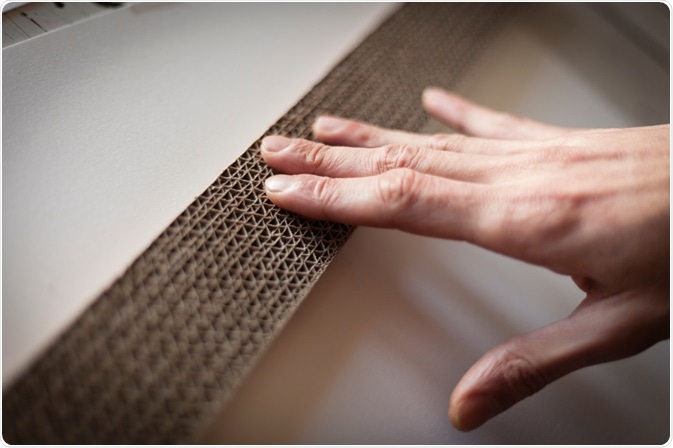How Does the Brain Respond to Texture?

The human hands and fingertips are extremely sensitive to texture or surface microstructure, which can easily perceive the finest details of a surface’s characteristics.
The nerve signals sent from the sensors in the hand skin are processed by several neurons in the somatosensory cortex to produce a high-dimensional representation of texture in the brain.

Image Credit: Moha El-Jaw/Shutterstock.com
How does the brain respond to texture?
In the somatosensory cortex (the brain area responsible for encoding the sense of touch), different types of surface characteristics are processed by different kinds of neurons, which follow a differential pattern of activation in response to various characteristics of a surface to produce a high-dimensional representation of texture in the brain.
Mechanistically, fingertips sense the surface characteristics through various mechanoreceptors present in the skin. Of these sensors, slow adapting receptors are sensitive to the skin deformation caused by pressure applied by spatial elements of coarse textures, such as Braille-like dot patterns (static touch).
In contrast, fast adapting receptors are sensitive to vibrations produced by the movement of the skin over fine textures, such as fabrics (dynamic touch).
Processing of sensory inputs in the brain
The sensory signals are sent from the fingertip to the brain’s somatosensory cortex by three types of neurons (afferent neurons) using two neural mechanisms. For example, surface characteristics of a coarse texture are associated with spatial activation patterns, whereas fine characteristics are encoded through temporal spiking activation patterns.
In simple words, neurons in the somatosensory cortex respond to different tactile aspects highly distinctively. Touching a fine texture like velvet activates a particular subpopulation of neurons, whereas touching a rough texture like sandpaper activates another overlapping neuron population. Such a wide variety of neural responses is responsible for the richness of tactile sensation in humans and non-human primates.
Studies conducted on monkeys to directly evaluate neural activities in the somatosensory cortex have shown that there are no specific neurons designated for a specific surface characteristic.
In contrast, all the neurons get activated while touching a particular texture. What differs is the pattern and degree of neural activation. Interestingly, tactile differentiation is determined by the combinations of which neurons are activated while touching a particular texture.
Tactile dimensions
Like other sensory experiences (vision and olfaction), the tactile sensation is multidimensional. Some of the commonly encoded sensory dimensions, such as roughness, hardness, stickiness, etc., can describe a texture only partially.
Many other features are available to effectively define a texture, such as fuzzy, bumpy, or silky. The neurons in the somatosensory cortex process each characteristic of a texture at different spatial scales, in which some neurons are preferentially activated by coarse textures while others are activated by fine textures.
Altogether, these neural signals form a high-dimensional representation of texture in the brain.
Can tactile sensations be recreated through a neuroprosthetic?
Hypothetically, brain-controlled robotic prosthetic hands fitted with touch sensors can be used to restore or recreate the sensation of textures. However, given the highly heterogeneous nature of texture-responsive neurons, this task can be challenging.
In other words, it is difficult to create the sensation of texture through electrical stimulation in the brain, because all neurons in the somatosensory cortex that respond to texture-related sensory inputs are mixed, and there is no specific neuronal population that responds to specific features of a texture.
Sources
- Dana Foundation. 2019. How our brains respond to texture. https://www.dana.org/article/how-our-brains-respond-to-texture/
- Lieber JD. 2019. High-dimensional representation of texture in somatosensory cortex of primates. PNAS. https://www.ncbi.nlm.nih.gov/pmc/articles/PMC6386651/
- Skedung L. 2013. Feeling Small: Exploring the Tactile Perception Limits. Scientific Reports. https://www.ncbi.nlm.nih.gov/pmc/articles/PMC3771396/
Further Reading
- All Brain Content
- Human Brain Structure
- Language and the Human Brain
- Human Brain Pathology
- Studying the Human Brain
Last Updated: Apr 14, 2020

Written by
Dr. Sanchari Sinha Dutta
Dr. Sanchari Sinha Dutta is a science communicator who believes in spreading the power of science in every corner of the world. She has a Bachelor of Science (B.Sc.) degree and a Master's of Science (M.Sc.) in biology and human physiology. Following her Master's degree, Sanchari went on to study a Ph.D. in human physiology. She has authored more than 10 original research articles, all of which have been published in world renowned international journals.
Source: Read Full Article